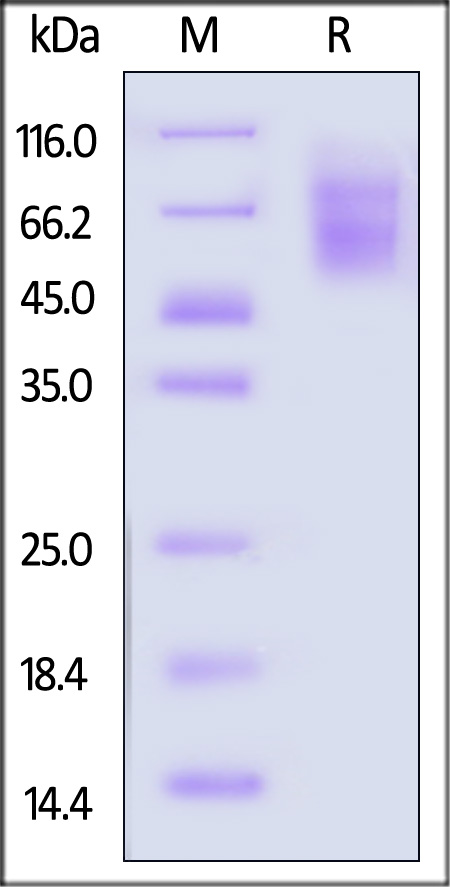分子别名(Synonym)
TIM4,TIMD4,SMUCKLER
表达区间及表达系统(Source)
Human TIM-4 Protein, His Tag (TI4-H52H3) is expressed from human 293 cells (HEK293). It contains AA Glu 25 - Gln 314 (Accession # Q96H15-1).
Request for sequence
蛋白结构(Molecular Characterization)

This protein carries a polyhistidine tag at the C-terminus
The protein has a calculated MW of 33.4 kDa. The protein migrates as 55-90 kDa under reducing (R) condition (SDS-PAGE) due to glycosylation.
内毒素(Endotoxin)
Less than 1.0 EU per μg by the LAL method.
纯度(Purity)
>95% as determined by SDS-PAGE.
制剂(Formulation)
Lyophilized from 0.22 μm filtered solution in PBS, pH7.4 with trehalose as protectant.
Contact us for customized product form or formulation.
重构方法(Reconstitution)
Please see Certificate of Analysis for specific instructions.
For best performance, we strongly recommend you to follow the reconstitution protocol provided in the CoA.
存储(Storage)
For long term storage, the product should be stored at lyophilized state at -20°C or lower.
Please avoid repeated freeze-thaw cycles.
This product is stable after storage at:
- -20°C to -70°C for 12 months in lyophilized state;
- -70°C for 3 months under sterile conditions after reconstitution.
电泳(SDS-PAGE)

Human TIM-4 Protein, His Tag on SDS-PAGE under reducing (R) condition. The gel was stained with Coomassie Blue. The purity of the protein is greater than 95%.
背景(Background)
The T cell immunoglobulin mucin (TIM) proteins regulate T cell activation and tolerance. An essential step during clearance of apoptotic cells is the recognition of phosphatidylserine (PS) exposed on apoptotic cells by its receptors on phagocytes. The phosphatidylserine (PS) receptor Tim-4 mediates phagocytosis of apoptotic cells by binding to PS exposed on the surface of these cells, and thus functions as a PS receptor for apoptotic cells. Tim-4 directly binding to PS and functioning as a tethering receptor for phagocytosis of apoptotic cells has been extensively studied over the past decade. However, the molecular mechanisms by which Tim-4 collaborates with other engulfment receptors during efferocytosis remain elusive.























































 膜杰作
膜杰作 Star Staining
Star Staining












